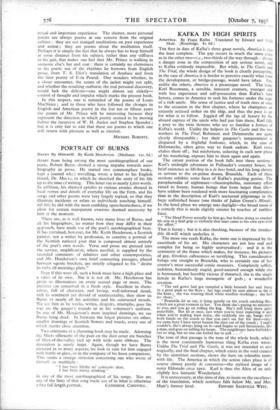APART from bein g amon g the most autobio g raphical of our poets,
Robert Burns showed a strong impulse towards auto- biography in prose. He started two commonplace books, kept a journal when travelling, wrote a letter to his English friend, Dr. Mocrc, in which he sketched the story of his life up to the time cf writing. This letter ran to nearly 5,000 words. In addition, his rhymed epistles to various cronies abound in local names and details of everyday life on the farm, and his songs and other poems were very largely topical, so that they illustrate incidents or relate to individuals touching himself. All this he did with the most confiding open-heartedness, if we alloW for certain transparent evasions deemed necessary by him at the moment.
There are, as is well known, very many lives of Burns, and all his biographers, no matter how they may differ in their approach, have made use of the poet's autobiographical bent. It has remained, however, for Mr. Keith Henderson, a Scottish painter, not a writer by profession, to contrive a portrait of the Scottish national poet that is composed almost entirely of the poet's own words. Verse and prose are pressed into the service, amplification, where needful, is supplied by the recorded comments of relatives and other contemporaries, and Mr. Henderson's own brief connecting passages, placed between square brackets, are strictly relegated to his " desire to make all meanings plain."
Even if this were all, such a book must have a high place and a value of its own. But it is not all. Mr. Henderson has given us illustrations on every second page or more. The pictures tre conceived in a fresh style. Excellent in them- selves, full of character, and loving, well-informed detail, rich in sentiment yet devoid of sentimentality, they show us Burns in nearly all his activities and his contrasted moods. We sea him as he works, writes, despairs, triumphs, goes his way on the gauger's rounds or in his volunteer's uniform. In one of Mr. Hendcrson's most inspired drawings, we see Burns lying dead. In between the larger pictures are other, smaller drawings of Scottish-flowers and weeds, every one of which merits close attention.
Two criticisms of a charming book may be made. Adorning the Miers silhouette of the poet on the dust cover are bunches of lilies-of-the-valley tied up with wide satin ribbons. The decoration is surely inapt. Again, though we have Burns pictured in so many aspects, we look in vain for him engaged with bottle or glass, or in the company of his boon companions. This seems a strange omission concerning one who wrote of himself so truthfully :
" I hae been blythe wi' comrades dear,
I Ilse been merry drinking " in one of the most autobiographical of his songs. Nor are any of the lines of that song made use of in ivliaf is otherwisea fine full length portrait. CATHERINE CARSWELL.














































 Previous page
Previous page